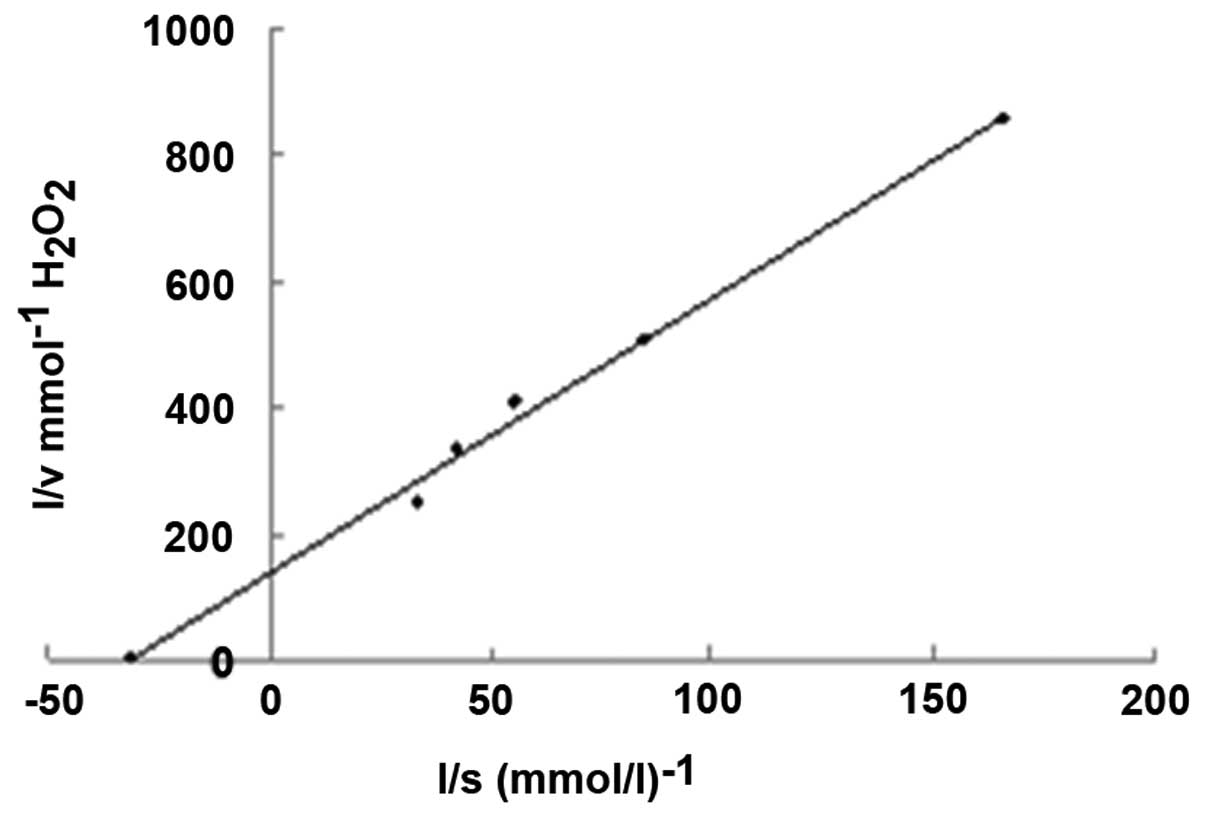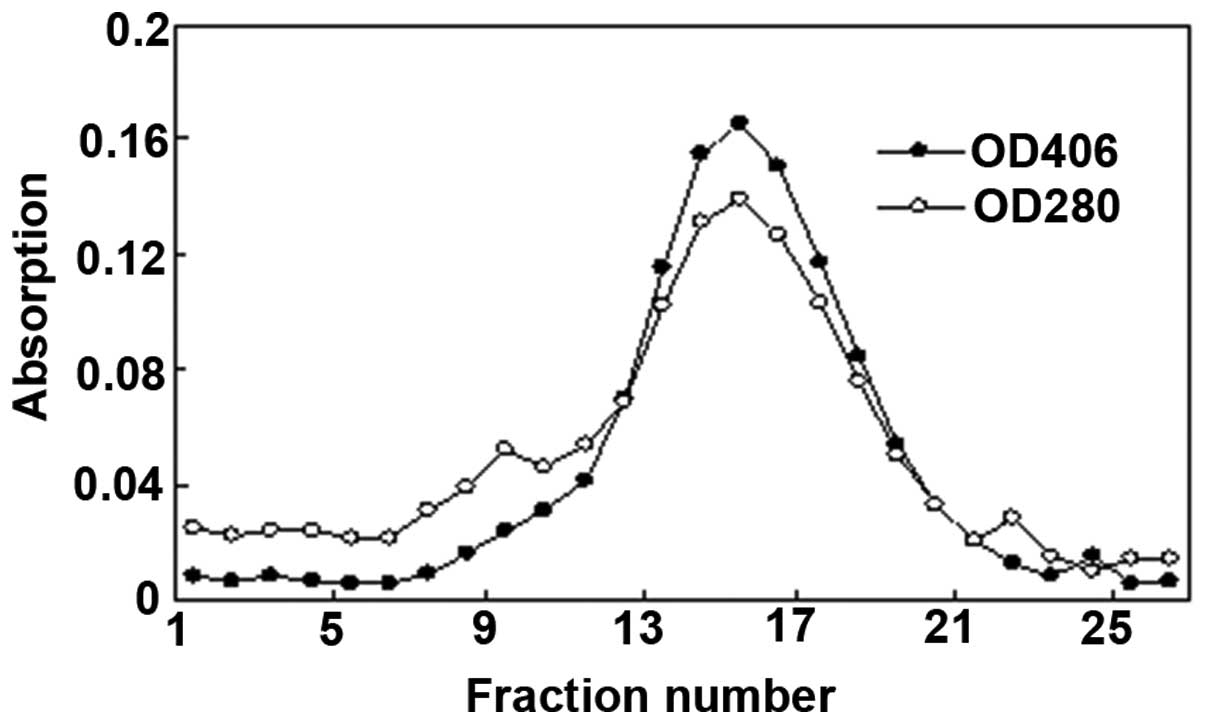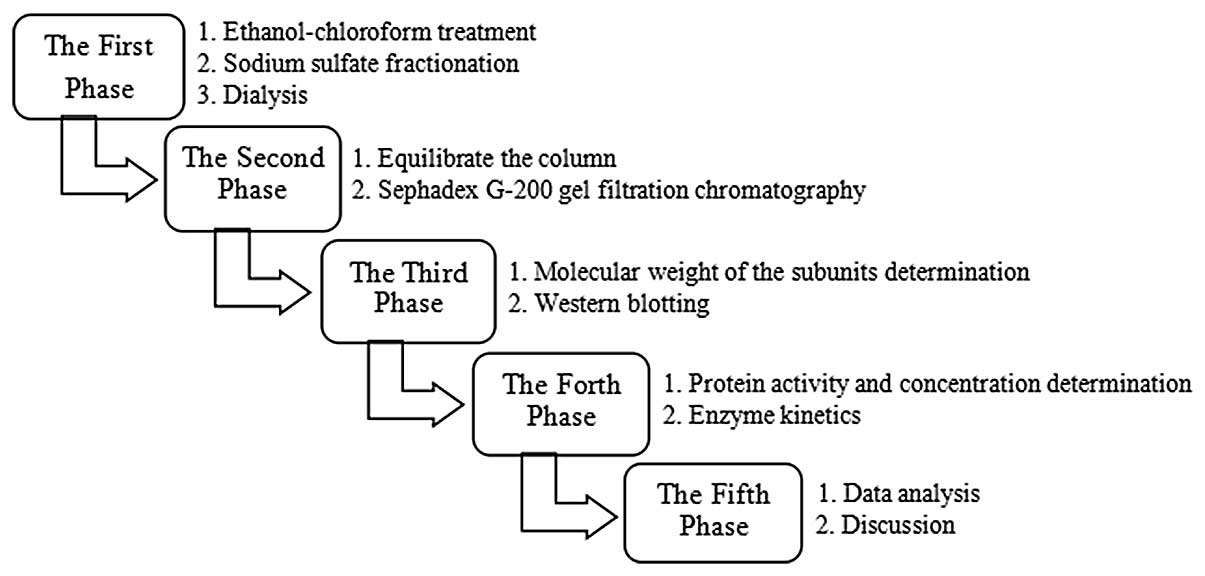A simple method of catalase purification for the undergraduate experimental course
- Authors:
- Published online on: October 29, 2014 https://doi.org/10.3892/mmr.2014.2806
- Pages: 1340-1343
Abstract
Introduction
Catalase (EC 1.11.1.6), the most abundant protein in peroxisomes, is ubiquitously present in mammalian and non-mammalian aerobic cells, which contain a cytochrome system. This enzyme is important in the removal of toxic hydrogen peroxide from the cell. Catalase exists as a dumbbell-shaped tetramer of four identical subunits, which contains a heme at the catalytic center (1). The molecular weights of the catalases range between 230 and 250 kDa (2). Aydemir and Kuru demonstrated that catalase activity is stable at a broad pH range between 5.0 and 10.5, and at temperatures between 10 and 30°C (3). Catalase is widely used as a typical example of a peroxisomal enzyme during biochemistry and molecular biology teaching due to its specific characteristics, including high efficiency, high specificity and stability.
The crystallization of beef liver catalase was first reported by Sumner and Dounce in 1937 (4). A number of studies, notably those of Price et al on rat liver catalase, of Maimoni Gonçalves et al on human placenta catalase and of Chatterjee and Sanwal on goat lung catalase, have demonstrated various methods of catalase purification in mammals (5–7). Despite developments in molecular cloning and the industrial production of proteins using ‘artificial’ microorganisms, catalase purification remains an obligatory step due to the cost and complexity of these methods in the majority of circumstances (8).
Although there is now substantial information on catalase purification, the most common limitation in the junior-grade undergraduate experimental course is the expense of the materials and equipment required to perform modern experimental methods. In Chinese medical universities, junior-grade undergraduates are required to undertake two or three school years of study, according to teaching programs, together with their counterparts in the same class. Several basic courses, including biochemistry, molecular biology, physiology and immunology are required during their junior year, from which students are expected to build on a wide knowledge (9). As the junior-grade undergraduates of medical schools are relatively concentrated and are required to learn additional types of courses, the use of new and advanced technologies in undergraduate classes is beyond the budget of the majority of universities and reduce satisfaction in the fundamental courses (10,11). The present study aimed to describe a simple method for purifying catalase from mouse liver that relies solely on ethanol-chloroform treatment, sodium sulfate fractionation, dialysis and Sephadex G-200 gel filtration chromatography.
Materials and methods
Animals and reagents
In total, eight 4-month-old Kunming mice of cleaning grade II, weighing between 20 and 25 g, can be used for each pair of students. The mice were supplied from the Experimental Animal Center at Hebei Medical University (Shijiazhuang, China). The absorbance was obtained using a 752 N UV-Vis spectrophotometer (Nanjing Everich Medicare Import and Export Co., Ltd, Nanjing, China) and the relative intensities of the blots were analyzed using a JD801 imaging analysis system (Jiangsu JEDA Science-Technology Development Co., Ltd, Nanjing, China). The rabbit anti-mouse catalase polyclonal antibody and the horseradish peroxidase labeled goat anti-rabbit immunoglobulin G polyclonal (cat. no. ZB-2301) were purchased from Zhongshan Golden Bridge Biotechnology Co., Ltd. (Beijing, China). The standard catalase was supplied from Beijing Tian Qin Yi He Biotech Co., Ltd. (Beijing, China. The use of animals was reviewed and approved by the Hebei Medical University Animal Ethics Committee (Shijiazhuang, China).
Sodium sulfate fractionation
Sodium sulfate (0.5 mol/l) was added to the supernatant by 0.06 volume of supernatant, which produced a marked turbidity and was then left to stand for 1 h at 4°C and centrifuged at 5,100 × g at 4°C for 10 min. The precipitate was dissolved in the minimum quantity of 0.1 mol/l sodium phosphate buffer (pH 7.8) and re-centrifuged at 2,300 × g for 10 min to remove the insoluble precipitate.
Dialysis
The supernatant was dialyzed against dialysis buffer (0.1 mol/l acetate buffer, 0.1 mol/l NaCl, 20% ethanol) at 4°C for 12 h, and centrifuged at 5,100 × g for 10 min. The precipitate was collected by centrifugation (5,100 × g for 10 min) and dissolved in 0.1 mol/l sodium phosphate (pH 7.8). The insoluble material was then removed by centrifugation (2,300 × g for 10 min).
Sephadex G-200 gel filtration chromatography
The supernatant was applied to a Sephadex G-200 column (1.8×32 cm; Suolaibao Bio-technology Co., Ltd, Shanghai, China), which was previously equilibrated using 0.1 mol/l sodium phosphate (pH 7.8). As the liver is rich in catalase, it was possible to use tiny columns of packed materials. The enzyme was eluted with the same buffer at a flow rate of 0.3 ml/min. The peak eluted from the Sephadex G-200 revealed two bands following absorbance analysis at 280 and 406 nm, which were characteristic for the protein and the heme group, respectively. The fractions surrounding the peak, with an OD406/280 ratio exceeding 1.08, were then pooled.
Enzyme assay
Catalase activity was measured using a potassium permanganate titration method (10). For assay of the activity, the enzyme preparation of each purification step was diluted with 0.1 mol/l sodium phosphate buffer (pH 7.8). The diluted enzyme preparation was then added to the buffer containing 40 mmol/l H2O2 and incubated at 25°C for 10 min. The reaction was then terminated using 95% sulfuric acid and the remaining H2O2 was titrated using 2 mmol/l potassium permanganate (2KMnO4 + 5H2O2 + 3H2SO4 → 2MnSO4 + K2SO4 + 5O2↑ + 8H2O). One unit of catalase activity was defined as the quantity of enzyme able to decompose 1 μmol H2O2/min under standard assay conditions.
The protein concentration was measured using the method detailed by Lowry et al, which used bovine serum albumin (Beinuo Biotech Co., Ltd., Shanghai, China) as the standard protein (12).
Enzyme kinetics
The catalase activity was measured by the increase in hydrogen peroxide concentration ranging between 8 mmol/l and 40 mmol/l in 0.1 mol/l sodium phosphate(pH 7.8), according to the method of titration previously described (13). The apparent Km H2O2 value was estimated using a Lineweaver-Burk plot.
Determination of the molecular weights of the subunits
The molecular weights of the subunits, assuming a globular structure for the catalase, was determined by SDS-PAGE electrophoresis. The enzyme preparation was separated by SDS-PAGE using a 2.5% stacking gel and a 12% running gel. The proteins in the running gel were then made visible by staining with Coomassie Brilliant Blue R-250 (Beinuo Biotech Co., Ltd.). The molecular weight calibration markers were: 94.0, 66.2, 45.0, 35.0, 24.0, 20.0 and 14.4 KDa.
Western blot analysis
The purified enzyme was identified by western blot analysis, in which 4.0 μg protein was loaded into each well, separated on SDS-PAGE gels and transferred onto a nitrocellulose membrane. The rabbit anti-mouse catalase antibody was the added to bind to the epitope of the target protein and the primary antibody was recognized by the relative secondary antibody labeled with horseradish peroxidase. The relative intensities of the blots were quantified by densitometry using the JD801 imaging analysis system.
Results
Catalase purification
The purification profile of the catalase from mouse liver is shown in Table I. The highest specific activity (1.68×105 U/mg) was obtained from the Sephadex G-200 column. Catalase was purified 31.8-fold with an 18.3% yield. Aydemir and Kulin purified catalase from chicken erythrocyte cytosolic fractions 139.59-fold with a 1.68% yield (3). The difference in the purification fold may be due to the present study using only gel filtration chromatography, which increases the ease of performance and reduces the cost of use in the student laboratory.
The Km value of the enzyme was 32.3 mmol/l, measured using a Lineweaver-Burk plot at pH 7.8 and 25°C (Fig. 1). The lower Km value of 32.3 mmol/l for mouse liver catalase compared with 93 mmol/l for bovine liver catalase demonstrated a greater affinity of catalase towards H2O2 (14).
The molecular weights of the subunits of mouse liver catalase were determined using SDS-PAGE electrophoresis (Fig. 2). The SDS-PAGE revealed one polypeptide band at the expected position at a mass of 58.3 KDa. Furuta et al observed subunits with a similar molecular mass of 59.758 KDa (15). The value corresponds to the major monomeric form of the enzyme.
Enzyme identification
This catalase enzyme was confirmed using two techniques. Fig. 3 shows the results of the separation of catalase and other proteins by Sephadex G-200 gel filtration chromatography. The absorption spectrum of the purified enzyme revealed two major peaks at 280 nm (due to the protein) and at 406 nm (due to the heme group). The overlapping peak of 280 and 406 nm was collected and the optical density 406/280 ratio exceeded 1.08. In addition, western blot analysis was used to identify the enzyme on the basis of the affinity between a certain antigen and its relative antibody. As shown in Fig. 4, one band was observed in the enzyme preparation at the same position as the standard catalase protein control.
Discussion
The present study demonstrated a straightforward method for purifying catalase from mouse liver that relies solely on ethanol-chloroform treatment, sodium sulfate fractionation, dialysis and Sephadex G-200 gel filtration chromatography. Al-Bar and Omar described a method to purify camel liver catalase by the preparation of crude extract, ammonium sulfate precipitation and chromatography on diethylaminoethyl cellulose-sepharose (16). Although camel liver is rich in catalase, it is difficult to obtain camel liver, which limits its use for junior-grade undergraduates. Yang and DePierre presented a method of purification from mouse liver catalase by immobilized metal ion affinity chromatography (17), however, this was expensive and complex to perform due to the requirement of prior treatment to materials. By comparison, the purification procedure described in the present study did not require specific equipment and was performed using the material and apparatus present in the majority of student laboratories, making it adaptable to the junior-grade undergraduate experimental course.
It is possible that the method described in the present study, can be performed, with data analyzed and discussed, in 2–3 days as the liver is rich in catalase, the method is sensitive and few materials are used. In addition, due to the high stability of catalase, the flexibility of the procedure enables it to be finished continuously or discontinuously in stages. In the majority of China’s medical schools, the experimental course is not a separate course, but is included in the fundamental courses taught during theoretical knowledge teaching (18). The majority of junior-grade undergraduates only have a 4-hour biochemistry and molecular biology experiment course every week and are unable to complete a large purification experiment in one occasion; therefore, the method presented in the present study many be more popular as students are able to complete the purification procedure in phases according to their experiment course arrangements. An example of a schedule for the overall operation procedure is shown in Fig. 5.
In addition, the method introduces several fundamental laboratory theories to students in terms of biochemistry and molecular biology. These theories include that of dialysis, the process of separating molecules in solution by differences in their rate of diffusion through a semipermeable membrane and chromatography, the technique of separating components of a mixture according to the different affinities for a fixed or stationary phase and their differential solubility in a moving or mobile phase. Students are able to acquire two separation techniques through the entire procedure. In addition to the theoretical knowledge inherent to the purification procedure, the purified enzyme can be used to learn certain basic enzyme characterization techniques, including western blotting, determination of protein activity and concentration and protein molecular weight determination.
In conclusion, the present study demonstrated the purification of mouse liver catalase using basic equipment, common to the majority of junior-grade undergraduate laboratories. Throughout this purification process, students are able to gain experience of laboratory techniques, acquire valuable data analyzing skills and understand research ideas, which are highly relevant to biochemistry and molecular biology. In addition, the procedure described has the potential to improve the comprehensive and manipulative ability of students, and develop their sense of innovation in their junior years.
Acknowledgements
This study was supported by the Higher Education Reform Project of Hebei Province of China. The authors would like to thank Dr Lingling Jiang of the Institute of Basic Medicine for their critical evaluation.
References
|
Kirkman HN and Gaetani GF: Mammalian catalase: a venerable enzyme with new mysteries. Trends Biochem Sci. 32:44–50. 2006. View Article : Google Scholar : PubMed/NCBI | |
|
Baird MB, Massie HR and Birnbaum LS: Presence of a high-molecular-weight form of catalase in enzyme purified from mouse liver. Biochem J. 163:449–453. 1977.PubMed/NCBI | |
|
Aydemir T and Kuru K: Purification and partial characterization of catalase from chicken erythrocytes and the effect of various inhibitors on enzyme activity. Turk J Chem. 27:85–97. 2003. | |
|
Sumner JB and Dounce AL: Crystalline catalase. Science. 85:366–367. 1937. View Article : Google Scholar : PubMed/NCBI | |
|
Price VE, Sterling WR, Tarantola VA, Hartley RW Jr and Rechcigl M: The kinetics of catalase synthesis and destruction in vivo. J Biol Chem. 237:3468–3475. 1962.PubMed/NCBI | |
|
Maimoni Gonçalves V, Cezar de Cerqueira, Leite L, Raw I and Cabrera-Crespo J: Purification of catalase from human placenta. Biotechnol Appl Biochem. 29:73–77. 1999.PubMed/NCBI | |
|
Chatterjee U and Sanwal GG: Purification and characterization of catalase from goat (Capra capra) lung. Mol Cell Biol. 126:125–133. 1993. | |
|
Alenkin D, Yermekbayeva L, Mujib S, Vesterberg A, Newman E, Yamazaki K, Cossar D and Dhe-Paganon S: A centrifugation-free high-throughput protein purification system using in-line microfluidization. Protein Expr Purif. 79:204–209. 2011. View Article : Google Scholar : PubMed/NCBI | |
|
Lam TP, Wan XH and Ip MS: Current perspectives on medical education in China. Med Educ. 40:940–949. 2006. View Article : Google Scholar : PubMed/NCBI | |
|
Wang HF and Zhan HJ: The research progress in determination of catalase activity. Science and Technology Innovation Herald. 19:7–8. 2009. | |
|
Xiao WW, Ma WL and Zhang XM: Present situation of biochemical experiment teaching and its reform strategies. Xi Bei Yi Xue Jiao Yu. 15:270–271. 2007.(In Chinese). | |
|
Lowry OH, Rosebrough NJ, Farr AL and Randall RJ: Protein measurement with the Folin phenol reagent. J Biol Chem. 193:265–275. 1951.PubMed/NCBI | |
|
Dixon M: The graphical determination of Km and Ki. Biochem J. 129:197–202. 1972.PubMed/NCBI | |
|
Switala J and Loewen PC: Diversity of properties among catalases. Arch Biochem Biophys. 401:145–154. 2002. View Article : Google Scholar : PubMed/NCBI | |
|
Furuta S, Hayashi H, Hijikata M, Miyazawa S, Osumi T and Hashimoto T: Complete nucleotide sequence of cDNA and deduced amino acid sequence of rat liver catalase. Proc Natl Acad Sci USA. 83:313–317. 1986. View Article : Google Scholar : PubMed/NCBI | |
|
Al-Bar and Omar AM: Characterization of partially purified catalase from camel (Camelus dromedarius) liver. Afr J Biotechnol. 11:9633–9640. 2012. | |
|
Yang Q and DePierre JW: Rapid one-step isolation of mouse liver catalase by immobilized metal ion affinity chromatography. Protein Expr Purif. 12:277–283. 1998. View Article : Google Scholar : PubMed/NCBI | |
|
Schwarz MR, Wojtczak A and Zhou T: Medical education in China’s leading medical schools. Med Teach. 26:215–222. 2004. View Article : Google Scholar : PubMed/NCBI |














